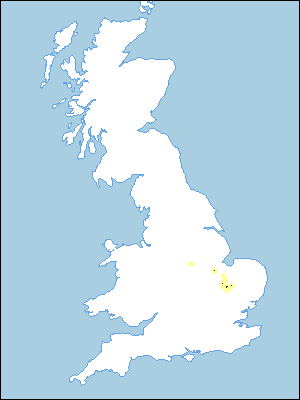
Soil Associations
0872b Clayhythe
Soil and site characteristics
Deep humose fine loamy over sandy and fine loamy over clayey soils mainly calcareous. Some peat soils. Groundwater controlled by ditches and pumps.
Geology
River terrace drift
Cropping and Land Use
Cereals, sugar beet and potatoes.
Component soil series
| Subgroup | Series name | Percentage | WRB 2006 link |
|---|---|---|---|
| 8.72 | CLAYHYTHE | 60% | Calcaric Mollic Gleysols |
| 8.72 | GOTHAM MOOR | 15% | Mollic Gleysols |
| 8.71 | DUCKPIT | 10% | Calcaric Mollic Gleysols |
| 10.24 | ADVENTURERS' | 10% | Drainic Rheic Sapric Histosols |
Covers 51 km2 in England and Wales
Soilscapes Classification
| 23 |
Loamy and sandy soils with naturally high groundwater and a peaty surface |
0872b Clayhythe
Detailed Description
The Clayhythe association covers 58 km² and consists mainly of fine loamy over sandy Clayhythe and fine loamy Gotham Moor series (both calcareous humic gley soils). The soils are permeable or moderately permeable and are formed in river terrace drift once covered by thin peat which has now wasted, leaving humose or dark coloured topsoils. The association is found mostly in Cambridgeshire but there are small areas near Market Deeping, Lincolnshire, and on Gotham Moor south of Nottingham. The land is flat and in the Fens north of Cambridge, where it is part of the skirtland, lies just above sea level and is drained by ditches and pumps. In places, the river-terrace drift is thin so the Duckpit series (typical humic gley soils) occurs with its humose fine loamy topsoils and fine loamy subsurface layers which pass sharply into grey clay subsoils. Adventurers' series (earthy eutro-amorphous peat soils), which is found locally in the lowest places, was more extensive prior to drainage and oxidative wastage of the peat. On the highest ground the organic matter in the topsoils is now so oxidized that they are non-humose but remain dark coloured. Humose calcareous clay soils, Peacock series, are found where river terrace drift is absent. Where the soils are very acid through oxidation of pyrites, there are clayey sulphuric soils belonging to Manea series, and peaty sulphuric soils of the Mendham series. The subsoils of most component soils are grey and heavily mottled, a relic from the time before the land was drained.
The association is most extensive in Cambridgeshire mainly between Cambridge and the Isle of Ely. The Clayhythe series occupies about a third or more of the land and the Gotham Moor series about a fifth. The Manea and Mendham series are generally found on the lowest ground. On the highest land, which has long been drained, limed and cultivated, the soils are mostly calcareous and near Cambridge the proportion of humose soils is now small. East of the Cam, where river terrace drift adjoins the Cambridgeshire Greensand, some land was disturbed by coprolite workings in the last century. Near Market Deeping, the Gotham Moor series is dominant. Here clayey alluvial soils of Fladbury and Downholland series also occur.
Soil Water Regime
The subsoils of the main series are permeable. The Clayhythe series in particular has sandy and sometimes stony subsoils through which water moves laterally, provided there are adequate outfalls. Tile drainage is required where subsoils are clayey. With the generally adequate systems of field ditches, main drains and pumps, the dominant series are well drained (Wetness Class I).
Cropping and Land Use
Both Clayhythe and Gotham Moor series are easily worked and cultivation can take place a few days after heavy rain at most times of the year without risk of soil damage. There is generally ample time in autumn for cultivations though the wetter Peacock, Manea, Fladbury and Duckpit series require more careful handling, especially in spring. The land is cropped intensively with winter cereals, sugar beet and potatoes. The water holding capacity of the soils depends on the organic matter content of the topsoils, the thickness of the upper loamy layers and, to a lesser extent, the presence of clay in the subsoils. Clayhythe soils with low organic matter contents and sandy subsoils at shallow depth are moderately droughty in the dry climate. Yields are reduced in dry years and potatoes in particular require irrigation to yield well.
0872b Clayhythe
Distribution Map
 |
Note that the yellow shading represents a buffer to highlight the location of very small areas of the association.
Keys to component soil series
Eastern Region
 |
Typical Landscapes
Eastern Region
 |
All information Copyright, Cranfield University © 2025
Citation: To use information from this web resource in your work, please cite this as follows:
Cranfield University 2025. The Soils Guide. Available: www.landis.org.uk. Cranfield University, UK. Last accessed 25/04/2025
